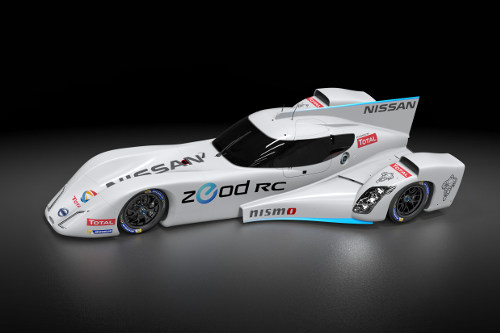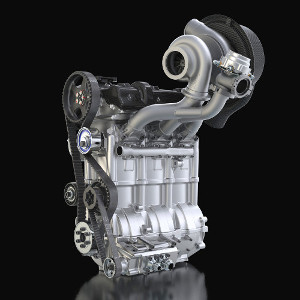 |
| June 03, 2014 | Volume 10 Issue 21 |
Designfax weekly eMagazine
Archives
Partners
Manufacturing Center
Product Spotlight
Modern Applications News
Metalworking Ideas For
Today's Job Shops
Tooling and Production
Strategies for large
metalworking plants
Wheels:
Nissan set to make hybrid history at 24 Hours of Le Mans with revolutionary small gas engine and electric ZEOD RC powerplant
Editor's Note: RACE UPDATE is at the end of this article.
A Nissan reacecar with an incredibly small, 400-hp three-cylinder gasoline engine and an all-electric running option is set to make history at this year's 24 Hours of Le Mans road race.

The Nissan ZEOD RC.
Nissan is set to not only break new ground with its unique electric power plant aboard the Nissan ZEOD RC car, but the accompanying internal combustion engine is aiming to revolutionize standards of performance and efficiency. ZEOD stands for "zero emissions on demand."
The dual-mode Nissan ZEOD RC will become the first entry at the legendary Le Mans endurance race to complete a lap of the Circuit de la Sarthe (aka Circuit des 24 Heures) under nothing but electric power when the event takes place June 14-15. A single lap of each stint (a fuel "stint" lasts approximately one hour) will be electric powered, then the new Nissan DIG-T R 1.5-liter three-cylinder turbo engine will take over.
VIDEO: Jason from Engineering Explained tells us all about the ZEOD RC's internal combustion engine that is capable of 400 hp from just 40 kg of weight.

The small three-cylinder combustion engine of the Nissan ZEOD RC car produces an ultra-impressive 400 hp.
The racecar is also set to become the world's fastest electric racing car, reaching speeds of more than 300 km/hr (186 mph).
The incredibly small engine weighs only 40 kg (88 lb) but produces an astonishing 400 hp. The base engine is only 500 mm tall x 400 mm long x 200 mm wide (19.68 in. x 15.74 in. x 7.78 in.). Just how small is that? Well, while the engine is technically too heavy to take as carry-on luggage on a plane, it would easily fit inside the luggage guides seen at major airports around the world.
Revving to 7,500 rpm, the Nissan DIG-T R produces 380 Nm of torque. At a ratio of 10 hp/kg, the new engine actually has a better power-to-weight ratio than the new engines that will be used in the FIA Formula 1 World Championship this year.
"The Nissan ZEOD RC is a natural progression that follows on from the development of the Nissan LEAF road car and the LEAF RC race car prototype," says Ben Bowlby, Nissan ZEOD RC designer and Nissan's Director of Motorsport Innovation. "The technologies developed through the ZEOD RC program will form part of future innovations for Nissan road cars. Nissan is already a global leader in the sale of all-electric cars and we're eagerly awaiting the opportunity to showcase the lessons learnt with the development of battery technology in the world's oldest, toughest, and most high-profile endurance race."
VIDEO: Take another look at the combustion engine on the Nissan ZEOD RC. In this video, you can really get a sense of how small the engine is.
Launched in 2010, the Nissan LEAF has become the world's best-selling all-electric car.
"A zero-emission on-demand option where the driver can switch between electric and petrol-powered drive is a future direction for road cars, so that will be tested in addition to pure electric power and other new technologies that we still have under development," says Bowlby.
While current battery technology does not provide the energy storage capacity to race a solely electric Le Mans prototype, Bowlby believes the development of the car will be an important step in the "electrification" of the racecars of the future.
"Our design team on the Nissan ZEOD RC program has concentrated heavily on packaging and aerodynamic efficiency that will not only provide extreme performance but high levels of energy efficiency -- the goal for all global automakers," says Bowlby
VIDEO: Nissan's Ben Bowlby answers some questions about the Nissan ZEOD RC design.
The Nissan car is not the only vehicle running some type of electric propulsion at this year's race, but how does this car differ in its battery technology from what Audi and Toyota are doing at Le Mans?
"Audi and Toyota are running pure KERS [kinetic energy recovery system] solutions, but we're looking at using electric technology in very different ways," says Bowlby. "We have a couple of different options we'll be testing -- one where we'll switch between electric and petrol power with the push of a button. We're building an extremely flexible platform with which we'll be able to try multiple different options, even during the same multi-day test. It is about experimenting and gathering data to work out how we use electricity to develop a competitive LM P1 program in the future."
And just what can this car achieve using its two 110-kw electric motors?
Bowlby says that the Nissan ZEOD, under electric power alone, could actually run laps around Le Mans faster than a Ferrari GT car. "This is a sub four-minute lap," he says. "It would be a record, because there is no official race lap record for a pure EV car. It's an extremely exciting statement. It tells us where the technology of the battery-electric vehicle stands today. But this is just one of the options we have for 'electrifying' Le Mans. This is an intensive development program that we are also going to showcase to the fans."
VIDEO: A 2013 overview of the project with some more engineering details.
With the entire concept of the Nissan ZEOD RC focusing heavily on downsizing and efficiency, Nissan turned to new lubricants partner Total to help develop the engine. The French lubricants manufacturer has worked closely with Nissan engineers to develop fuel and lubricants to maximize the potential of the engine.
The Nissan ZEOD RC will occupy "Garage 56" at this year's 24 Hours of Le Mans, an additional entry reserved by the Automobile Club de l'Ouest for new and ground-breaking technologies never previously seen at the classic French endurance event.
Lessons learned from the development of the revolutionary racecar will also be used in the development of Nissan's planned entry into the LM P1 class of the FIA World Endurance Championship in 2015.
"Our engine team has done a truly remarkable job with the internal combustion engine," says Darren Cox, Nissan's Global Motorsport Director.
"We knew the electric component of the Nissan ZEOD RC was certainly going to turn heads at Le Mans, but our combined zero-emission on-demand electric/petrol power plant is quite a stunning piece of engineering," Cox says. "Nissan will become the first major manufacturer to use a three-cylinder engine in major international motorsport. We're aiming to maintain our position as industry leaders in focusing on downsizing. Lessons learned from the development of the engine will be seen in Nissan road cars of the future.
"Our aim is to set new standards in efficiency in regards to every aspect of the car -- powertrain, aerodynamics, and handling. For the powertrain, we have worked closely with the team at Total to not only reduce friction inside the engine, but within all components of the powertrain. Friction is the enemy of horsepower, and tackling that has been one of the efficiency targets we have concentrated on heavily."
VIDEO: Wolfgang Reip explains how the ZEOD RC steering/control module works and what each button does. Yup, it really does look like a video game controller!
After extensive dyno testing, the Nissan ZEOD RC hit the track for the first time mid-January 2014 with both the electric and internal combustion engines in place. Both the gas and electric powerplants run through the same five-speed gearbox that transfers power to the ground via Michelin tires.
"Being chosen by a car manufacturer as a technological partner to achieve a demonstration of innovation is always a source of pride, especially on this legendary race -- 24 Hours of Le Mans," says Philippe Girard, Scientific Delegate for Total. "It drives our researchers to find solutions and get the most out of the technical specifications as well as the fuel economy properties that our TOTAL QUARTZ lubricants range provides to all passenger cars."
The Nissan ZEOD RC has undergone an extensive test program schedule over the last four months prior to making its race debut at this year's 24 Hours of Le Mans event in June. All that's left now is to see how the car fares on race day.
RACE UPDATE 6/14/2014
The planned assault of Nissan's ZEOD RC electric prototype on the Le Mans 24 Hours race ended early due to a mechanical problem, but the revolutionary racecar left the event a winner of sorts having reached its historic goals of hitting 300 km/h (186 mph) on the Mulsanne Straight and recording a complete lap of Le Mans on electric power only.
The car was also the first in modern history to compete at Le Mans without traditional rear-view mirrors. The Nissan ZEOD RC drivers are made aware of what is happening behind them through a camera and integrated radar system -- technologies that are being tested to further enhance road car systems like the Nissan Safety Shield.
The unique prototype -- which features both internal combustion and electric power sources -- reached its first target during Thursday night qualifying when driver Satoshi Motoyama exceeded 300 km/h before the first chicane on the Mulsanne Straight.
Nissan's other key goal was to complete an entire 8.5-mile lap of Le Mans on pure electric power. GT Academy winner Wolfgang Reip was at the wheel when the team achieved this goal during the morning warm-up.
Reip started the race aboard the ZEOD RC and completed five laps before losing drive at the 23-minute mark. A suspected gearbox issue caused an early retirement.
Remarkably, the gearbox was one of the more traditional parts of the powertrain package. Both the 1.5-liter, 40-kg, 400-hp, three-cylinder engine and the pair of 110-kW 40,000-rpm electric motors had performed flawlessly in the early part of the race.
Source: Nissan UK, Nissan Motorsports (NISMO)
Published June 2014
Rate this article
View our terms of use and privacy policy
